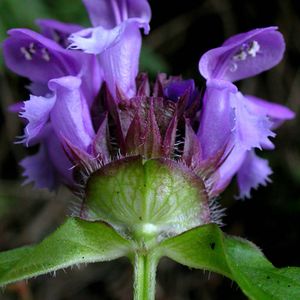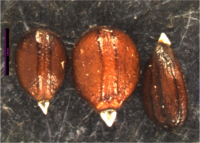Prunella vulgaris
- Scientific Name: Prunella vulgaris
- Family: Lamiaceae
- Common names: self-heal, all-heal, healall
- Codon: PRUVUL
Contents
Taxonomy
| Scientific classification | |
|---|---|
| Kingdom: | Plantae |
| Subkingdom: | Viridiplantae |
| Phylum: | Tracheophyta |
| Subphylum: | Spermatophytina |
| Class: | Magnoliopsida |
| Subclass: | Asteranae |
| Order: | Lamiales |
| Family: | Lamiaceae |
| Genus: | Prunella L. |
| Species: | Prunella vulgaris L. |
Description
Perennial rhizomatous herb, erect to decumbant with blue-violet to white flowers whorled in terminal spikes, growing to 50 cm long.[2] Stems square, solitary or clustered, glabrous to sparsely puberent.[3] Leaves opposite, elliptic to broadly ovate, entire.[4] Spikes bractate;[5] flowers zygomorphic; calyx 7-10 mm long, green to purple,[2] bilabiate, upper lip 3-toothed, lower lip 2-cleft;[5] corolla bilabiate, 1-2 cm long,[3] upper lip entire, galeate, lower lip 3-lobed;[5] stamens 4, didynamous; style 2-branched, ovary superior, 2-celled, becoming 4 nutlets.[3]
2 varieties in Salish Sea area, Prunella vulgaris var. lanceolata, a widespread native variety, with middle cauline leaves about one third wide as long and more tapering towards the base, and Prunella vulgaris var. vulgaris, introduced from Europe, middle cauline leaves about half as wide as long, with broadly rounded bases, stems often more decumbent than erect.[5]
Distribution
Alaska south, both sides of Cascades to California, East to Atlantic.[5]
Habitat
Wet to dry roadsides, lawns, fields and open forests, low to high elevation. [2]
Propagation
Prunella vulgaris can be propagated by stolon, division, or seed. Propagation by stolon yields larger plants in a shorter amount of growing time. Stolons root wherever they touch soil. Cold-stratify seeds for approximately one month. Seeds can be started in flats, and when the plants are large enough to handle (approximately eight weeks) they can be transplanted into individual pots and grown to the desired size. Seeds may also be sown directly on site, preferably in late Fall to early Spring. [2]
Uses
Prunella vulgaris has a long history of medicinal use everywhere it grows, as alluded to by its common name. [4]
Fore example, use as a skin medicine for boils, cuts, bruises, and inflammation by Salish and Quinalt peoples, Haudenosaunee use as an infusion for shortness or heaviness of breath, or for beravement, Niitsitapi use as an eyewash to keep eyes moist in harsh winds.[6]
Seed
Seed sample from: 2010
Average Measurement: 2.1 x 1.6 x 1.1
Measurement Range: L: 1.8 - 2.3, W: 1.3 - 1.9, D: 0.75 - 1.2
Features
Shape: Seeds narrow at hilum end and broadening at opposite apex. Hilum protruding in a “v” or “u” shape.
Color: Seeds dark brown with black ribbing. Hilum white.
Surface: Seeds longitudinally striated with darker lines. Entire seed is very glossy, especially hilum.
Latitudinal Cross Section: elliptical ![]()
Longitudinal Cross Section: elliptical ![]()
Basic Explanations and Assumptions:
The dimensions for the seeds are length x width x depth. The location of the hilum is used as the base of the seed, and the length is measured from hilum to the opposite apex. Where a style is present, the length is measured from the hilum to the bottom of the style. Width is measured at a right angle to the length at the widest part. Depth is measured at a right angle to the intersection of height and width lines.
Measurements included are the mean average for each measurement of ten separate seeds.
All measurements in millimeters unless otherwise noted.
Photo Gallery
References
- ↑ Integrated Taxonomic Information System. Retrieved from https://www.itis.gov/servlet/SingleRpt/SingleRpt?search_topic=TSN&search_value=32381#null
- ↑ 2.0 2.1 2.2 2.3 Electronic Atlas of the Plants of British Columbia
- ↑ 3.0 3.1 3.2 WTU Herbarium, Burke Museum, & University of Washington. Retrieved from https://biology.burke.washington.edu/herbarium/imagecollection/taxon.php?Taxon=Prunella%20vulgaris
- ↑ 4.0 4.1 Bowcutt, F., & Hamman, Sarah. (2016). Vascular plants of the South Sound prairies (First ed.). Olympia, Washington: The Evergreen State College Press. p. 92.
- ↑ 5.0 5.1 5.2 5.3 5.4 Hitchcock, C. L., Cronquist, A., Giblin, D., & Legler, B. et al. (2018). Flora of the Pacific Northwest: an illustrated manual. Seattle: University of Washington Press. pp.485-486.
- ↑ Native American Ethnobotany Database. Retrieved from http://naeb.brit.org/uses/search/?string=prunella+vulgaris
Prunella vulgaris. E-Flora BC: Electronic Atlas of the Plants of British Columbia [eflora.bc.ca]. Lab for Advanced Spatial Analysis, Department of Geography, University of British Columbia, Vancouver.








